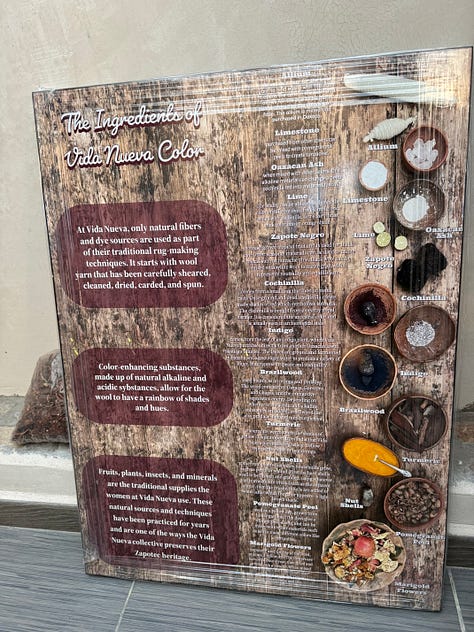The Skilled Weavers of Teotitlán and Santa Ana
Oaxaca's renowned rug weaving towns, Teotitlán del Valle and Santa Ana del Valle, are both worth the stop
The high desert starts almost as soon as you leave the city limits of Oaxaca de Juárez.
The desert isn’t immediately apparent because you quickly encounter Santa María del Tule, a town famed for its towering cypress tree which is said to be around 1500 years old. Tule is flat and particularly friendly to tourists, acting as a gateway to the Camino del Mezcal, the government-granted name for the long, narrow highway which runs east from the city. The camino is studded with agave fields and mezcal distilleries (called palenques) and Tule itself is blanketed by small businesses selling mezcal by both the bottle and the glass out of small concrete rooms that are similar in size and design to storage units, or concrete garage bays. The variety of mezcal is so huge, so bewildering to those uninitiated into the pleasures of the smoky spirit, that if you’re hoping to get a sense of what’s going on your best option is to wander from shop to shop tasting as you go.
If you can wrest yourself away from the drinks and restaurants of Tule (El Milenario is particularly good for chiles rellenos) you’ll find the Camino del Mezcal is really just a two-lane highway named Route 190 which crosses a long expanse of red-tinted rocky fields. The road stretches in a more-or-less straight line and the arid, crusty plain is covered in both wild cacti and orderly, cultivated rows of spiny agave. It is undeniably beautiful and grows particularly spectacular when you approach the roundabout which leads into Teotitlán del Valle, one of Oaxaca’s most famed artisan towns.
We’ve visited Teotitlán a few times over the past couple of years, drawn there by the handwoven wool rugs they are so famous for.
The road to Teotitlán begins abruptly with a large, modern, two-lane concrete slab which runs for several hundred feet before it turns into a standard Mexican paved road. The short stretch of very modern road is so out of keeping with the rest of the town that it looks like it fell from space, and perhaps it serves some sort of purpose I just can’t ascertain, serving to shore up a particularly loose or flood-prone section of road. I suspect, though, the concrete heralds a future where Teotitlán is modernized in a way that expressly aids the ebb and flow of tour busses, which is how most visitors get there. Local friends said to us, “it may not look like it, but Teotitlán has money,” and a major infrastructure project would confirm that.
You’ll start seeing signs, figuratively and literally, of weaving and business almost as soon as you start driving the road, which ascends at a leisurely pace toward to the village, which sits at the base of a mountain. “ENGLISH SPOKEN" appears prominently on signs (not something you’ll see in many other Oaxacan villages) and rugs flutter in the breeze, heralding the wares for sale inside of various homes. For many people that is where they are both making and selling their goods—in their homes.
Buying rugs in Teotitlán is an extremely pleasurable way to spend an afternoon, but it can be a little nerve-racking. It’s not to say you’ll be placed in a high-pressure sales environment, but when you’re in someone’s home, looking at something they made by hand on a large, sometimes rather ancient wooden loom which hulks just next to you, it can be hard to say “thanks, we’re just looking.” And while Teotitlán may have more money than other pueblos, the gulf between Oaxacan village wealth and American wealth remains enormous. Haggling is not just in poor form, it borders on being grotesque.
During our previous trips to Teotitlán we went with a few recommendations, but largely weren’t sure where to go. Penny and Victor recommended a shop called Manos Que Tejen (“Hands That Weave”) and we were greatly impressed by both the modernity of their designs, and by the large sizes they offer. The majority of the rugs you’ll find will be at most 3’x5’ or perhaps 5’x7’, as the rugs can only be as large as the looms they’re made on. Manos Que Tejen had rugs large enough to fill an entire room. It’s only the more prosperous that can afford an external space for their looms, and as a result many looms are on the smaller side.
It can be hard to differentiate one shop from another. Often the rugs a shop has most prominently displayed are virtually identical to those being highlighted by other shops. And without an eye for detail, some knowledge of dyes and dying technique, and some education about how to identify themes and motifs in the patterns, you’d largely just be picking based on aesthetics. There’s certainly nothing wrong with that, but we had hoped to shop a bit more conscientiously, so we asked our friend Ehren, who runs the fabulous online shop Hecho and works directly with a number of artisans, for advice on where we should visit.
It was Ehren who recommended we visit Santa Ana del Valle, which lies just 15 minutes east of Teotitlán. “Since Santa Ana Del Valle doesn’t have the fame that Teotitlán does, the prices are more accessible,” Ehren said. But the real draw for us wasn’t (just) the possibility of savings, it was that Ehren was able to connect us with her friend Alicia, whose family weaves in their home. Ehren’s taste is impeccable and the opportunity to buy from someone she knew and vouched for made us feel much more secure than we have in the past when wandering blindly from taller (workshop) to taller.
Because we had a tight schedule and went directly to Alicia’s house we saw very little of Santa Ana del Valle, but what we passed suggested it is both more boisterous than Teotitlán, which whenever we’ve visited has felt rather sleepy, and also less wealthy. We followed a long, winding dirt road until we were quite high up on a hill and parked near the large metal gate of a home compound.
It was Alicia’s daughter-in-law who greeted us with an infant in her arms and a toddler enthusiastically waving at us the moment arrived. In the home’s courtyard she showed us the family’s wooden looms and the rugs that were in progress, highlighting the difference between wool made colorful with artificial dyes (more vibrant) and those tinted with natural dyes (muted, but richer in tone).

Weavers can work quite quickly, but as one might expect the more intricate the work, the greater the time required, and the greater the price. Natural dyes are also made from foraged ingredients, which adds even more time and effort, because of the time needed to harvest the ingredients and the effort of making the dyes and infusing the wool with them. At times a rug, called a tapete, may also be woven with two types of wool, one type dyed with natural dyes and the other with artificial dyes, allowing for rich, but more neutral tones to be paired with bright pops of contrasting color.

After visiting Alicia we decided to go to women’s collective in Teotitlán which sells rugs, pillows, bags, and other woven items made by women who are single mothers, who are divorced, or whose husbands may be working in other places or countries. The work done by the collective, and its tienda, have been written about and it is very high quality, while the organization itself is extremely community-oriented. We learned before we left that 100% of the profits collected by the tienda go to the women who made the rugs, and that the organization is supported not by sales but by grants and donations.
We fell in love with both the tienda and the mission of the organization, and before we left we received a hands-on lesson in how the dyes are made. The shop also has a variety of posters describing the significance of different patterns, as well as descriptions of how the natural dyes are made. Every rug made by the collective is done with natural dyes, making them premium products.



You certainly don’t have to go to Teotitlán or Santa Anna to find work that has been made there, as there are many shops in Oaxaca de Juárez carrying rugs from the valleys, but going directly to the communities helps to cut out middle people, giving the owners themselves more profit. And purchasing weavings made by women and sold by women directly helps to improve equity in these communities and has a very real impact.
Shopping in Oaxaca can be a deeply pleasurable way to spend time, in large part because the quality of the crafts made here is so high. But it is particularly magical for us because these world-class artisans lie so close to us. A drive of an hour or so will put us in villages that by all accounts should be world famous for their art and skill. Splendor is at our doorstep, in the high, rocky desert of Oaxaca.








Beautiful photos and neat story on Oaxaca weavers. Thank you.